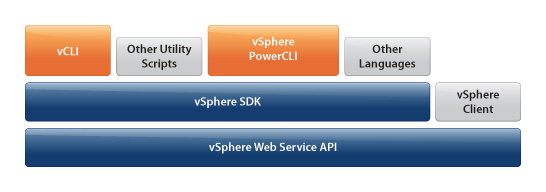To automate the management of an ESXi deployment, VMware has created easy-to-use scripting tools for managing day-to-day operations. You can write scripts with the same functionality as the vSphere client to automate manual tasks , allowing you to manage small- to large-scale environments efficiently. These tools work well with both ESXi and ESX hosts, allowing you to easily administer mixed environments.
Both PowerCLI and vCLI are built on the same interface as the vSphere Client. They can be pointed directly at an ESXi host or they can be pointed at vCenter. When pointed at a host, they can execute commands directly on an ESXi host, similar to how a command in the Console OS of ESX operates on only that host. Local authentication is required in this case. Alternatively, when communicating through vCenter, the vCLI and PowerCLI commands benefit from the same authentication (e.g. Active Directory), roles and privileges, and event logging as vSphere Client interactions. This provides for a much more secure and audit-able management framework
VMware vSphere™ PowerCLI
VMware vSphere PowerCLI is a powerful command line tool for automating all aspects of vSphere management, including host, network, storage, VM, guest OS and more. PowerCLI is distributed as a Windows PowerShell snapin, and includes more than 150 PowerShell cmdlets, along with documentation and samples. PowerCLI seamlessly blends the vSphere platform with Windows and .NET, which means you can use PowerCLI by itself or within many different 3rd-party tools
VMware vSphere™ Command Line Interface (vCLI)
VMware vSphere™ Command Line Interface (vCLI) is a set of command-line utilities that help you provision, configure and maintain your ESX and ESXi hosts. The vCLI command set allows you to run common system administration commands against VMware ESXi systems from any machine with network access to those systems. You can run most vCLI commands against a vCenter Server system and target any ESXi system that the vCenter Server system manages. There are commands that can completely automate the initial configuration of an ESXi host and others that provide troubleshooting and diagnostic capabilities. VMware provides vCLI packages for installation on both Windows and Linux systems
VMware vSphere™ Management Assistant (vMA)
The VMware vSphere™ Management Assistant (vMA) is a virtual appliance that brings together all the tools you need to manage vSphere. vMA packages the vSphere Command Line Interface, the vSphere SDK for Perl, as well as logging and authentication modules into one convenient bundle. vMA can also host 3rd-party agents for added management power.



Leave a Reply